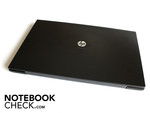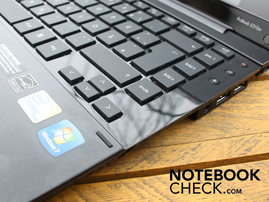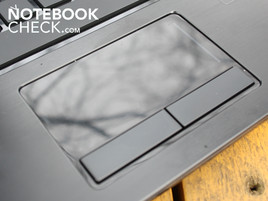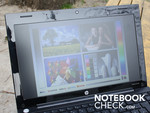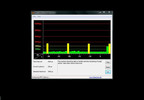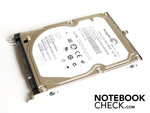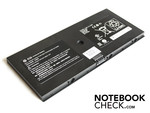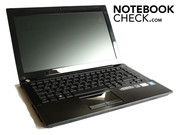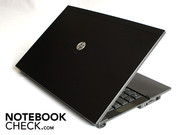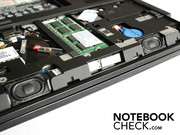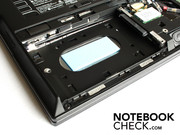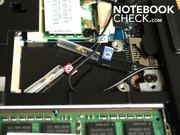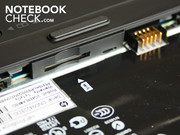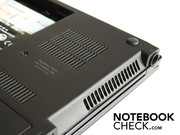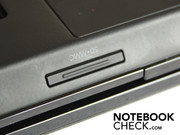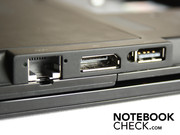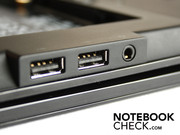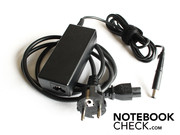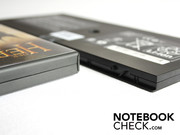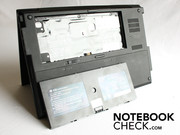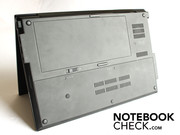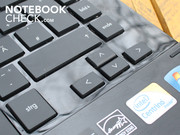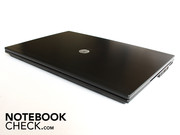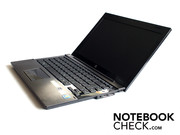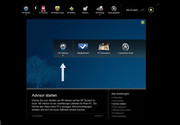Review HP ProBook 5310m Notebook
A Really Flat Business Book
HP's ProBook of 13.3 inches addresses business people with an affinity for design. The ULV dual-core processor represents high mobility but can also supply good performance. Nevertheless, who really wants smeary fingerprints on the touchpad? You will learn more about the HP ProBook 5310m in our comprehensive review.
MSI calls it X-Slim, Samsung simply X-series and Acer has named it Timeline. Flat notebooks with a long battery life are now fashionable. Additionally, the prices have also been created to be consumer-suitable in the meantime. The times in which private or business customers had to at least put 2000 euro on the table for a little laptop with a long battery life are over. The HP ProBook 5310m only costs 530 euro in its cheapest configuration. Our prototype, the 5310m VQ469E is almost the top model of the range with about 920 euro. The manufacturer's promised battery life of seven hours should be very realistic with the energy saving Intel Core 2 Duo SP9300 (2.26 GHz) and the 2800 mAh battery. More about that in mobility.
Case
The HP ProBook 5310m already attracts complaisant attention at unpacking. The matt black aluminum finish with the HP logo placed on the lid looks discreet and elegant. The case forgoes on any rounding and this already provides for an impressive character. The interior glances in a combination of matt and brushed aluminum and a black high-gloss coating. That what looks elegant at the first and second sight leaves evident traces already after only three hours of intense use.
On the one hand, the hands leave obvious fingerprints on the touchpad, on the lid and beside the keys. But that's not the only thing. Already after a short period, we discovered small, weak scratches in the arrow key's area. Potential buyers can vividly imagine how these glossy surfaces will look after only a few months of intensive use. We also discovered a cover thrown out of its joint on one place. The surrounding aluminum trimming of the power button had loosened itself notably from its background.
The edgy design makes a stable impression. However, the user will establish that the case twists a bit and that the battery doesn't sit tight at a closer look. We could also twist the lid visibly as we picked it up on one edge. But this doesn't blemish the overall impression. Conducive for the good impression is the firmly sitting wrist rest. We couldn't depress this anywhere, not even with strong finger pressure. The same applies for the case tray. The rubbery material of which the baseplate and the sides are made is resistant against scratchy fingernails. Striking: There aren't any stickers on the baseplate. Neither Windows' numbers nor manufacturer's codes have perpetuated themselves here. These labels have been stuck under the flat lithium ion battery instead. HP has even thought about tinkerers. There is an opening for exchanging the RAM (a built-in module), the hard disk, the WLAN module and for an UMTS card that can be built in optionally.
Connectivity
The ProBook 5310m doesn't have an optical drive on board. HP follows the example of the Acer Timeline range. Such a drive is first available with the 5810T, a 15.6 inch model. First the next in size ProBook model bids an integrated DVD drive. This is already a big 17 incher hallmarked HP ProBook 4710s. Whilst the 17 incher has almost all interfaces, the ports of the 13 incher can be counted on one hand: USB, display port, Ethernet, Headphone and Kensington. Okay, it's three USB ports. The connection alignment is on the level of a netbook, apart from the display port. An display port adapter for HDMI is already available for 10 euro. Adapters on VGA D-Sub don't exist because the display port doesn't emit an analog signal.
The omission of a docking port on the notebook seems a bit strange. Mobile business users don't want repeated cabling actions at their desk; they would rather like to see the notebook connected to a display, input and network with one click. A docking station isn't available for the HP ProBook range. Thus, users have to fall back on USB docking solutions. Meanwhile, these also have a DVI and VGA port option. The webcam beside the integrated dual-array microphone is almost standard for every notebook in the meantime.
HP has something new in terms of software configuration. It's not, as many might have desired, the reintroduction of the recovery DVD. This, as usual for HP, has to either be created by the user or he has to hope for that the hard disk will endure.
The novelties are the HP Advisor and the HP Dock. The dock is a bar on the display's upper edge, in which the user can pull the most used needed programs or files. The HP Advisor displays the system's most important key data. What does the battery life look like? How much space is left on the hard disk? Users who work with Windows' system control and know how to use My Computer will, however, gladly waiver on this feature.
Input Devices
Keyboard
The input just simply invites to type. The key field sits tight; the gaps between the keys are very big and thus perfectly suitable for touch-typists. It also has a distinct pressure point and a firm stroke. Even users of arrow and page keys don't have to turn their back on the notebook's keyboard. The key layout has a very good overview and a very high accuracy. Hotkeys are found discreetly placed on the right. The almost minute keys enable WLAN and Bluetooth, call on Internet Explorer or open the HP Software Setup.
Touchpad
Whilst the keys can convince with a matt, non-slip surface, the manufacturer selected a glossy surface for the touchpad. This doesn't prevent the user from controlling the mouse cursor precisely but leaves a ghastly smear film on the pad. This is rather superfluous in a notebook with which you mostly would want to work with on the go.
Display
The non-reflective 13.3 inch screen has a WXGA resolution of 1366 x 768 pixels. This is a good compromise between desktop overview and small symbols and fonts for a 33 centimeter sized screen. The ProBook 5310m's TFT screen is suitable for office tasks but not for vivid colors in movies or pictures with a background contrast ratio of 144:1.
| |||||||||||||||||||||||||
Brightness Distribution: 90 %
Center on Battery: 196 cd/m²
Contrast: 144:1 (Black: 1.365 cd/m²)
The TFT screen's brightness is only average in the subnotebook field. We measured an average of 192 cd/m2 over all nine measuring fields. The LED lit screen's brightness especially drops down to 180 cd/m2 in the lower area. However, this isn't visible to the eye.
HP uses a matt, so non-reflective 13.3 inch TFT in its HP ProBook 5310m. In terms with the useable brightness, this is a good precondition for a potential outdoor use. We first experienced annoying reflections and a too dark image in direct sunlight. In this case, the averagely reached 192 cd/m2 isn't enough to oppose the sunlight.
The viewing angles are acceptable, but in no way very good. Colors can't be clearly recognized already at a deviation of 20 degrees, when looking down on the screen's content. Script can't be read anymore at 50 degrees. The colors already bleach at 40 degrees deviation from the center on the horizontal plane. Thus, when several people are looking at the ProBooks 5310m's display, the ones on outer sides won't have much fun.
Performance
Hewlett Packard builds an Intel Core 2 Duo SP9300 (2 x 2,26 GHz) into its HP ProBook 5310m. The dual-core processor doesn't come from the CULV range which is exclusively built into Acer's Timeline notebooks or in Samsung's X-range. The SP9300 with a 6 MB L2 cache and 1066 MHz FSB counts to Intel's most efficient ULV processors. Already the clock rate of 2.26 GHz is unachieved by the CULV types. An Intel Core 2 Duo SU7300 processor (3MB L2 cache, 800 MHz FSB) merely has a 1.30 GHz clock rate, for instance. Of course, performance has a certain price, which is why an SP9300 probably won't be found in a low-priced 600 euro subnotebook so soon. The fast Intel processor is a main reason for the HP ProBook 5310m's high price. The 13.3 incher doesn't have much more to offer for a good 900 euro.
The Core 2 SP9300 CPU can even keep up the Intel's P8600 (2.4 GHz), P8700 (2.53 GHz) or T6500 (2.1 GHz) in the CPU benchmarks. We established a good 4757 points in Cinebench R10's multiple CPU test. The SP9300 is equal to the mentioned P and T processors in the single core CPU test.
The latencies under Windows are interesting. If these are too high, it can come to problems at connecting external devices (for example sound crackling with external sound cards or short interruptions in Real-Time-Audio). The values here were partially over 1000 µs. Problems with synchronization shouldn't turn up despite the high values. The reason for this was erroneous drivers of internal devices, such as WLAN adapter, sound card, USB host controller or others.
Strong subnotebook processor or not, you can't play on the HP ProBook 5310m. Intel's GMA 4500M HD is integrated into the chip set, which the GPU awards with 942 3DMark06 points. Current starter GPUs like ATI's HD4650 or Nvidia's Geforce GT230M easily reach 6000 points. We didn't test that for this reason.
| 3DMark 03 Standard | 2340 points | |
| 3DMark 05 Standard | 1316 points | |
| 3DMark 06 1280x768 Score | 942 points | |
Help | ||
The overall system performance is carried by the strong processor, the DDR3 RAM (2048) and the fast Seagate hard disk. The fast rotating 320 hard disk with 7200 rpm submits a very good 67.6 MB/s. A good value which the user has to pay for with a persistent noise from the HDD, though.
Emissions
System Noise
We experienced a rare case in the noises. The fan didn't bother us as much as the hard disk. Whilst the fan runs as quiet as a whisper in low load operation or even turns itself off completely (mostly in battery mode), the Seagate hard disk (Model ST9320423AS) attracts attention with a constant noise. It's not the write-read head's clacking but is quite more the basic motor noise or rather the rotating disk. This somewhat muffled noise is louder than the fan on both its lowest levels. This is the reason why the actually very quiet HP ProBook 5310m doesn't fall under 29.7 dB(A). When the hard disk reads or writes, the volume even increases to 31.2 dB(A) because the write-read heads clack very audibly.
Noise Level
| Idle |
| 29.7 / 29.8 / 29.8 dB(A) |
| HDD |
| 30.1 dB(A) |
| Load |
| 34 / 34.2 dB(A) |
 | ||
30 dB silent 40 dB(A) audible 50 dB(A) loud |
||
min: | ||
Temperature
The 5310m only develops slightly increased temperatures in idleness or surfing. The upper side heats up to an average of merely 28 degrees Celsius. The right side of the chassis remains considerably cooler with 26 degrees. The baseplate heats up in the area of the processor to a maximum of 36 degrees in idle mode. This is only a point measurement though, the average of the bottom is only 31 degrees. Whilst we only had to manage with a cool HP ProBook without processor or graphic load, the 13.3 incher had to cope with notably greater temperature increases under load. The bottom then even reaches 44 degrees at a point. The waste heat increases the working surroundings by three to six degrees. In view of the Intel Core 2 Duo SP9300's (2.26 GHz) good performance, the waste heat is still within an acceptable range and can be seen as uncritical.
(+) The maximum temperature on the upper side is 37 °C / 99 F, compared to the average of 35.9 °C / 97 F, ranging from 21.4 to 59 °C for the class Subnotebook.
(±) The bottom heats up to a maximum of 44 °C / 111 F, compared to the average of 39.4 °C / 103 F
(+) The palmrests and touchpad are reaching skin temperature as a maximum (34 °C / 93.2 F) and are therefore not hot.
(-) The average temperature of the palmrest area of similar devices was 28.3 °C / 82.9 F (-5.7 °C / -10.3 F).
Loudspeakers
The ProBook hasn't been conceived for entertainment reasons, which is why HP hasn't only waivered on a separate microphone in but also on a stereo sound system worth hearing. There are two loudspeakers but they have been placed very close to one another on the front. The sounds that we tickle out of the loudspeakers sound midrange-biased and slightly tinny. The volume is also very low. The 13.3 inch ProBook won't manage to fill a larger room with sound. HP omits the separate microphone-in but the unmarked 3.5mm socket is a combined microphone/headphone connection. At least theoretically because our stereo microphone with a three-conductor plug couldn't record anything. However the mono plug of another microphone did. Luckily, it has the integrated dual array microphone. It's above the display close to the webcam. The recordings are slightly layered with a white noise, but it suffices for a webcam chat.
Many users will connect external speakers to the 3.5 mm audio-out. In view of the sound, it's definitely necessary. We tested the audio output with two active Yamaha speakers (YST-M20SDP). The intensity attached to the notebook mustn't fall below the specific level of circa 25% because it otherwise comes to a slight noise.
Battery Life
The battery's life with only a capacity of 41 watt-hours (lithium ion) is short of four hours at WLAN surfing. We surfed on You Tube and news portals for our test. If you waiver on processor-biased video websites, you will more than likely surpass the 3:42 hours that we established. The ProBook reaches a proud maximum of 7:42 hours. This is, however, an unrealistic time because the computer remained in an idle state and we limited the processor's maximum performance state to 50 percent. The idle runtime gave us a notable break-down to 4:40 hours with a change in the performance state to 100 percent. We assessed the minimum runtime with the BatteryEater's Classic mode. Herewith everything was enabled including WLAN and Bluetooth. The display's brightness was set to maximum. We established 1:55 hours. This enormous difference, in opposition to the idle test, proves how well Intel's ULV SP9300 (2.26 GHz) processor's energy savings mechanisms work. When power is needed, like in the Reader's test classic mode, this is called upon. If little power is needed, then very good runtimes are possible, despite the very weak lithium-ion battery with 2800 mAh.
The good battery life is reflected in the low power consumption. Minimalists are satisfied with merely 7.8 watts in idle mode. We measured the average power consumption with a removed battery. The consumption is around 20 watts in typical office mode with enabled WLAN and a high brightness of the display. Good news for energy savings fans. There are only few subnotebooks that can undercut these values. The recently reviewed Asus UL30A-QX050V(13.3 inch) with merely four watts minimum power consumption counts to these.
| Off / Standby | |
| Idle | |
| Load |
|
Verdict
The HP ProBook 5310m is flat and enduring, but not a CULV notebook for the consumer target group, anyhow. The buyer basically gets a well manufactured 13.3 inch notebook with a non-reflective display at a price of a good 900 euro. The 5310m neither has an UMTS module nor a dedicated graphic card. But why is it so expensive in comparison to CULV notebooks like the Asus UL30A-QX050V? It's the high performance of the Intel Core 2 Duo SP9300 with a clock rate of 2.26 GHz. It's Intel's fastest ULV processor, aside from the SP9600 (2.53 GHz) and the SP9400 (2.4 GHz). The SP9300 can very well hold a candle to a Core 2 Duo P8700 or T6500.
The ProBook 5310m achieved a good computing performance with a good battery life of 222 minutes (surfing with WLAN), despite a 2800 mAh battery, for the subnotebook range. The idle mode power consumption of less than 10 watts is also impressive. Seagate's fast rotating 320 GB hard disk, however provides for a consistent noise level. Potential buyers that are looking for a quiet subnotebook will certainly be annoyed by the 7200 rpm hard disk's persistent noise.
HP also looses many rating points from the testers in view of the input devices. This is a real pity because the keys are perfect in form and feed back for mobile typists. However, our fingers left a flood of fingerprints on the touchpad and beside the keys. If you're not persistently cleaning it, you'd better hide your HP ProBook in your notebook case and not show it at meetings.


 Deutsch
Deutsch English
English Español
Español Français
Français Italiano
Italiano Nederlands
Nederlands Polski
Polski Português
Português Русский
Русский Türkçe
Türkçe Svenska
Svenska Chinese
Chinese Magyar
Magyar
